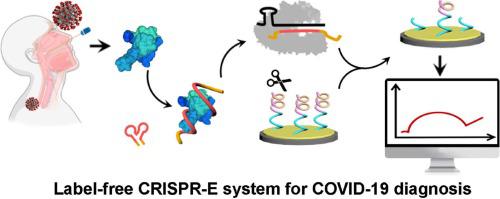Bioelectrochemistry ( IF 4.8 ) Pub Date : 2022-03-19 , DOI: 10.1016/j.bioelechem.2022.108105 Na Liu 1 , Ran Liu 1 , Jingjing Zhang 2

|
Serological antigen testing has emerged as an important diagnostic paradigm in COVID-19, but often suffers from potential cross-reactivity. To address this limitation, we herein report a label-free electrochemical aptamer-based sensor for the detection of SARS-CoV-2 antigen by integrating aptamer-based specific recognition with CRISPR-Cas12a-mediated signal amplification. The sensing principle is based on the competitive binding of antigen and the preassembled Cas12a-crRNA complex to the antigen-specific aptamer, resulting in a change in the collateral cleavage activity of Cas12a. To further generate an electrochemical signal, a DNA architecture was fabricated by in situ rolling circle amplification on a gold electrode, which serves as a novel substrate for Cas12a. Upon Cas12a-based collateral DNA cleavage, the DNA architecture was degraded, leading to a significant decrease in impedance that can be measured spectroscopically. Using SARS-CoV-2 nucleocapsid antigen as the model, the proposed CRISPR-Cas12a-based electrochemical sensor (CRISPR-E) showed excellent analytical performance for the quantitative detection of nucleocapsid antigen. Since in vitro selection can obtain aptamers selective for many SARS-CoV-2 antigens, the proposed strategy can expand this powerful CRISPR-E system significantly for quantitative monitoring of a wide range of COVID-19 biomarkers.
中文翻译:

用于 SARS-CoV-2 抗原检测的 CRISPR-Cas12a 介导的无标记电化学适体传感器
血清学抗原检测已成为 COVID-19 的重要诊断范例,但往往存在潜在的交叉反应。为了解决这一局限性,我们在此报告了一种基于无标记电化学适体的传感器,通过将基于适体的特异性识别与 CRISPR-Cas12a 介导的信号放大相结合来检测 SARS-CoV-2 抗原。传感原理基于抗原和预组装的 Cas12a-crRNA 复合物与抗原特异性适配体的竞争性结合,从而导致 Cas12a 的侧枝裂解活性发生变化。为了进一步产生电化学信号,通过在金电极上进行原位滚环扩增来构建 DNA 结构,金电极用作 Cas12a 的新型底物。在基于 Cas12a 的侧链 DNA 切割后,DNA 结构被降解,导致可以通过光谱测量的阻抗显着降低。以 SARS-CoV-2 核衣壳抗原为模型,所提出的基于 CRISPR-Cas12a 的电化学传感器 (CRISPR-E) 在核衣壳抗原的定量检测方面表现出优异的分析性能。由于体外选择可以获得对许多 SARS-CoV-2 抗原具有选择性的适配体,因此所提出的策略可以显着扩展这种强大的 CRISPR-E 系统,用于对广泛的 COVID-19 生物标志物进行定量监测。











































 京公网安备 11010802027423号
京公网安备 11010802027423号